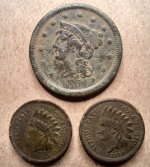retire05
Hero Member
- Feb 16, 2015
- 634
- 419
- Detector(s) used
- Garrett 350, AT Pro
- Primary Interest:
- All Treasure Hunting
OK, I've been metal detecting on land for 7 months but have taken a 2 month hiatus while I sold my house in Suffolk, VA. I really want to get into beach hunting a bit before the weather gets bad. Casper gave me some links to look at (thanks Casper!). He also suggested getting a book by Clive Clynick and or Gary Drayton. I just had a chance to look online at some books by these authors, but there has been several to choose from. Does anyone have advice on the best selection(s)? I'm trying to look online on you-tube for some pointers as well. See lots of sites that show what they have found, but not to many that dummy down how they determine where to go to start detecting other than the towel line. Any advice for a novice?
Brad
Brad
Upvote
0








